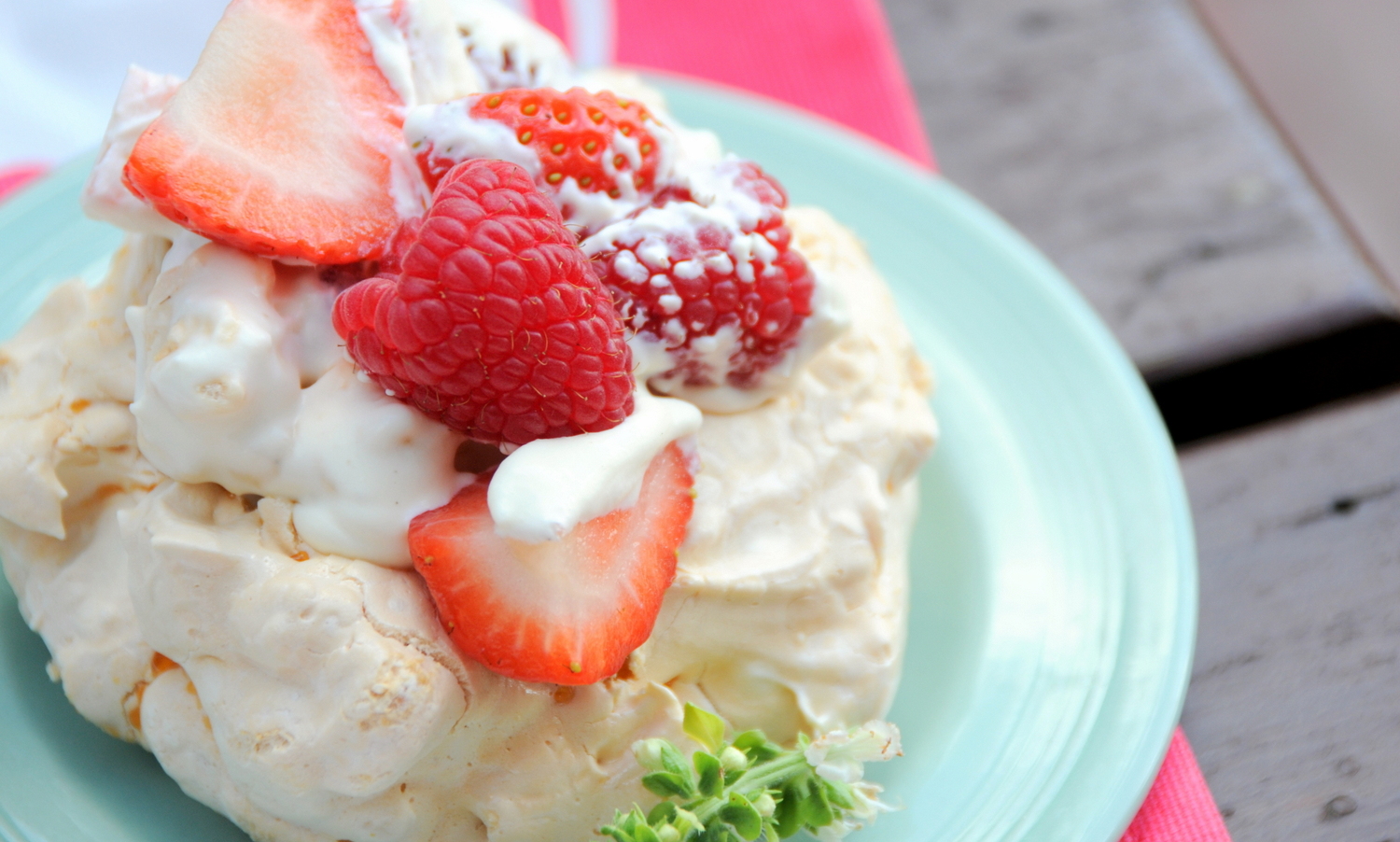Eton Neat
/ Back to Recipes
This is my much neater take on the classic Eton mess. It seems a monumental pity to break up a lovely big puff of meringue when this can serve as such a pretty nest for the Chantilly cream and berry topping … which, arguably, makes this a recipe for mini pavlovas – except that – there are no kiwi fruit involved (the inevitable result of a 1980s childhood lived in Australia is that pavlova and kiwi fruit are indelibly and unpleasantly linked). And there is some ‘mess,’ it’s just contained kind of ‘neatly’ inside the surrounding meringue nest.
A free-standing mixer does make life easier when it comes to meringue, though a decent handheld electric beater should suffice. (However, I say ‘should’ as the only reason I now own a decent hand beater is that I burnt out its predecessor over a bowl of particularly stiff meringue). A free-standing mixer is particularly handy when it comes to the bit where you are pouring hot caster sugar…
This recipe follows the recommendations of the Ottolenghi peeps in calling for the sugar to be heated in a 200˚C oven. A kind of half-way house between the French method (unheated sugar), and the Italian approach where sugar is melted to ‘soft ball stage’ at 115˚C, I feel that this produces a happy ratio of meringue stability versus super-sticky sugar-thermometer faff. To be on the extra safe side stability-wise, I add corn flour and vinegar – which also improves the chewiness of the meringue. But then, I’m like that with baking, it’s always the super-heaped teaspoon of baking powder, sneak a touch more bi carb in … why risk it?!
The recipe below produces individual dessert sized meringues, but with some piping bag skills, it can be easily adapted to create little bite-sized, or finger-food style versions. Topped with a smidgen of cream and a single raspberry, these are lots of fun, and tend to go down well at any party where cutlery is too much of an effort.
Ingredients
(Serves 6)
MERINGUES
- (These can be made up to four days prior to decorating if stored in a dry place).
- 180g egg whites (about 6 eggs)
- 330g caster sugar
- 1 heaped teaspoon corn flour
- ½ teaspoon of white vinegar
CHANTILLY
- 250mls whipping cream
- 2 tablespoons icing sugar
- Vanilla pod or 1 teaspoon good quality vanilla extract
FRUIT
- 250g of mixed berries – strawberries (halved), raspberries, blackberries, blueberries, & redcurrants all work beautifully. Use whatever you like/have available.
- 3 passion fruit (optional)
I like to use the small purple flowers off a Rosemary bush to garnish this, or the white-flowered seed-stems of a basil plant (pictured). Physalis fruit would also make a good garnish.
Method
Pre-heat the oven to 200˚C. Line a large baking sheet with parchment paper that extends beyond its edges, then spread the caster sugar across the sheet in an even layer, leaving a border of paper. The sugar won’t take long to heat once it is in the oven, so make sure that you have your egg whites separated and in the mixer bowl ready to go before you pop the sugar in the oven. The sugar is ready when it is only just beginning to melt at the edges. Keep a close eye on it – depending on your oven, this will take between 6 – 10 minutes… too melted and you’ll lose a lot of the sugar through attachment to the parchment paper.
When you think the sugar is almost there, start up the mixer on a high speed, quickly bringing the egg whites to the point where they are soft and aerated, just beginning to form peaks Remove the baking sheet from the oven, and pick up the lengthways edges of the parchment, bringing these together to form a kind of large pouring funnel. From here, with the mixer back on a high speed, begin to pour the sugar into the whites gradually – the parchment funnel should make it easy to control the flow, even if you are doing this one-handed as I often am when working without a free-standing mixer.
When all the sugar has been added, continue mixing until the meringue is cool, and the mixture very stiff, and super-glossy – this should take between 6-8 minutes.
Turn the oven down to 110˚C and prepare another baking sheet with parchment. I like to take a small saucer, or any other appropriately-sized disc-shaped object, and trace around its edge in pencil on the underside of the parchment to act as a guide for meringue placement. (And remember to space the meringues out appropriately as these will expand in the oven). This set-helps produce nice, uniformly sized meringues – things can get a little free-form working with huge spoonfuls of the sticky mixture otherwise! Once the shapes are traced out, it also helps to stick the parchment to the sheet with a touch of meringue mixture under each corner.
Using a serving spoon, dollop a big scoop of meringue into the centre of the first outline, bringing the spoon up in the centre to form a peak. Then pop a second, slightly smaller dollop, right on top, again pulling the spoon up from the centre, to form a little Mr. Whippy peak. Repeat until you have six similarly sized piles of lovely glossy meringue.
Cook these slowly at 110˚C for approximately 1½ hours. These are done when they can be lifted cleanly from the parchment and make a hollow-ish sound when tapped from below.
To prepare the Chantilly cream, add the scraped out vanilla seeds or vanilla extract if using, to the icing sugar and the cream. Whip these together to a soft consistency, so peaks form, but before the cream develops a churned look.
To assemble the individual meringues, take a small knife (a paring knife is ideal), and make a careful incision in the top of the meringue, ‘coring’ it to an extent by cutting around to lift off the top, and leave a bowl, or nest for the cream mixture. A bit of cracking can occur here, but the meringue should be sticky enough inside for the structure itself to withstand a bit of knife manoeuvring
This is where the promised ‘mess’ element comes back in! Crumble the meringue caps into the Chantilly, and mix this all together, along with half of the fruit. Now place generous scoops of this mixture back inside the meringue ‘bowls’ and top with the remaining berries, finishing with the passion fruit pulp if using.
Sprinkle some rosemary flowers, or whatever prettiness you have on hand atop, and voila! Dig in – the neatness is not destined to last long!
/ Back to Recipes

